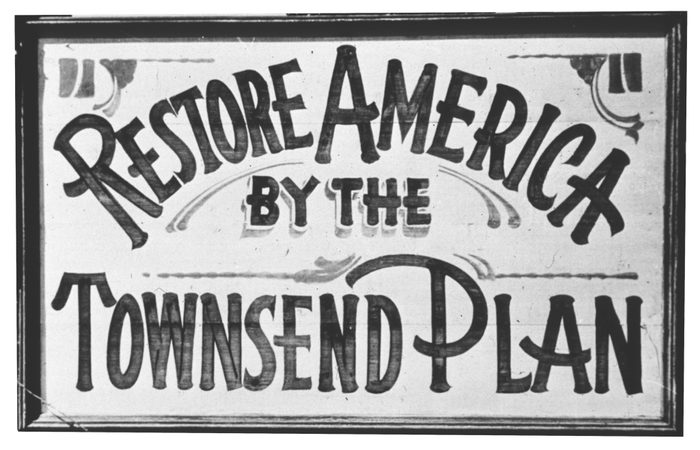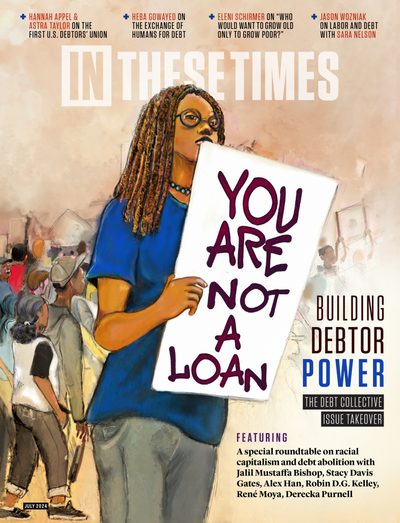Who Would Want to Grow Old Only to Grow Poor?
Seniors are increasingly in debt and facing financial crises at levels not seen since the Great Depression. The mass movement that fought for seniors 100 years ago under the banner of the Townsend Plan could be a model for solving the growing crisis now.
Eleni Schirmer

Despite the California sun in the summer of 1933, 66-year-old Francis E. Townsend’s mood was gloomy. He had just lost his job working as a physician for the Long Beach Health Department. Although the work itself had been bleak — attending to the city’s sick and poor was soul-wracking — not having a job was worse. Townsend, like millions of older adults during the Great Depression, found himself without savings, without work and, most of all, without hope.
Who would ever want to grow old, Townsend wondered, only to grow poor? Townsend was not alone in his despair; suicides among 65- to 74-year-olds reached levels higher than at any time before or since. One day, while staring out the window, he saw three old women digging through the trash for scraps of food. At this sight, Townsend nearly jumped out of his chair. As he later recalled, “A torrent of invective tore out of me, the big blast of all the bitterness that had been building in me for years. I swore, and I ranted, and I let my voice bellow with the wild hatred I had for things as they were.”
When Townsend’s wife — a South Dakotan named Wilhelmina Bogue — rushed to soothe him, Townsend batted her away: “I want God Almighty to hear me! I’m going to shout ’til the whole country hears.”
Soon enough, it did. Townsend got to work outlining the basis of what would become known as the Townsend Plan: $200 a month — $4,618 in 2024 dollars — for all retired citizens over 60, funded by a 2% sales tax. The plan would keep millions of elderly out of poverty, stimulate the economy and open up jobs. The only rule was that recipients would have to spend their entire sum each month. Townsend began writing letters to the editor on the topic and soon began to organize.
Seniors joined newly formed “Townsend clubs” by the thousands. This gray-haired army marched, petitioned, gathered and demanded that Congress and the president take up their cause. Although President Franklin D. Roosevelt had not previously included old-age pensions in his vision for reform, the drumbeat of the Townsend movement was impossible to ignore.
It pushed Roosevelt to sign his arguably most important legacy: the Social Security Act.
But nearly a hundred years later, seniors are still struggling. In spite of the Social Security Act, older Americans are not just poor — they are also increasingly in debt. Although Social Security is often celebrated as a beloved, if underfunded, social welfare program — a safety net for all aging Americans — its unfinished legacy haunts the country today. The Social Security Act was spurred by the boisterous Townsend movement of poor, old people and signed, in part, to contain the movement’s radical vision. Today, old people are increasingly in debt. Is it time for a new Townsend movement?
Whereas the Townsend Plan proposed pensions for nearly all — poor and rich, Black and white, men and women — Social Security was only available to select workers — mostly white men. Whereas the Townsend Plan would have been the first time men and women, Blacks and whites, received the same wage, the Social Security Act opened the door to differential pay rates, determined by states. Three-fifths of all Black workers were excluded from Social Security, and millions of women were left behind — including at least four-fifths of Black women — cementing a legacy of racial and gender wealth gaps.
Finally, whereas the Townsend Plan proposed that all Americans receive the same amount, Social Security benefits were set in proportion to wage earnings, ensuring that low-wage workers retired on smaller pensions, while high-wage workers retired on more, exacerbating class inequities.
In addition to creating Social Security, Roosevelt’s New Deal efforts, taken as a whole, unveiled a new form of government welfare: credit. Of the New Deal’s 31 major programs, 15 extended federally backed private capital to Americans looking to buy homes, farms and insurance. Today, the architecture of the credit-based welfare state remains.
But what starts as credit ends as debt. Absent a robust social safety net, millions of older Americans subsist on crushing loads of it. Between 1999 and 2019, Americans over 70 experienced a 543% increase in household indebtedness, causing a shocking rise in bankruptcies filed by older Americans. In 2021, while the federal government’s Covid relief measures radically expanded social protections, Americans over 65 were the only demographic to show increases in poverty.
For many aging Americans, their pension plan is their credit card.
The math, while cruel, is simple: Older Americans, facing decreasing social benefits, rely increasingly on debt to survive. More than one in five seniors has medical debt, despite the federal government’s basic healthcare for Americans over 65. Americans over 62 are the fastest-growing demographic of student debtors. One-third of seniors with medical debt report they have been unable to pay for basic necessities such as food, utilities and rent. Older debtors face declining physical and mental health, including increasing risks of depression and suicide.

Another silver social crisis looms
Take Jim Cummings, a 64-year-old resident of Philadelphia, who recently became a nurse. Cummings has built his life around his principles, not financial prerogatives. In his twenties, he pursued a doctorate in neuroscience; by the time he got to tackling a dissertation, he realized a scientific career in academia didn’t suit his values: too competitive, seemingly too detached from the world. Shortly after Iraq invaded Kuwait in 1990, sparking the first Gulf War, Cummings quit school and reoriented toward justice work. From his corner of West Philly, he started reading ecofeminism and socialism. He joined local social movement groups to abolish the death penalty and create public housing. For about a dozen years, he worked in a local private university’s library, where he helped to implement an interlibrary loan system. When the school lost funding and shut down, Cummings was forced to look for work; retirement was not financially possible.
At age 61, Cummings went back to school to become a nurse, work that was consistent with his values while financially supporting him. “It’s so human, seeing what another person needs,” Cummings said. “The capitalists can’t take that away from us.” To pay his tuition, he took about $35,000 from his retirement account and an additional $50,000 in private student loans. (Cummings was ineligible for federal loans because he didn’t register for the draft in 1980.) A few years prior, his wife had gone back to school for a master’s degree in social work.
Today, their family owes more than $250,000 in education debt.
A movement started with a letter to the editor
Francis E. Townsend was born in 1867 on a homestead in Illinois. His family moved to Nebraska when he was a child. He dropped out of high school and went west, hoping to make his fortune. For a decade, he roamed the West as a ranch hand, miner, salesman and teacher, eventually returning to Nebraska to enroll in medical school, graduating in 1903. In medical school, Townsend became involved with the Socialist Party of America, and as a country doctor in Belle Fourche, S.D., he began penning a regular socialist column in the local paper. He won an election to the city council, where his political agenda centered around eliminating saloons, gambling and prostitution. When he lost his bid for re-election, Townsend started looking for a way to leave town. When the Army put out a call for doctors in the lead-up to World War I, Townsend enlisted — at age 50. The war left Townsend in poor health.
Upon his return, Townsend and his wife set out westward for the El Dorado of Southern California, once again hoping to make his fortune. His first business was peddling dry ice, which flopped, and Townsend found himself, like millions around the country, out of money and in search of work. At one point, he tried his hand at real estate to little avail. With a friend’s help, he landed a job working in the Long Beach City Health Department, where he tended to the ill, the poor and the aging. He found the experience soul-wracking and transformative. “Men and women suddenly reduced to absolutely begging penury,” he wrote. “They were lost — gamely and hopelessly groping for something to cling to, some tangible enemy against whom they might prove their courage. … There was no one to fight.”
But it was only a thin line separating doctor from patient. In 1933, 66-year-old Townsend lost his job. “Things were not going too well in our home,” Townsend recalled in his memoir. “We were alone and, as day after day went by without a cent coming in, and with our slender bank account being paid out, we worried.”
It was this moment, legend goes, that Townsend happened to look out of his window in Long Beach. What kind of earthly hell makes elderly women pick through the trash to find their next meal? He began to scheme.
“We might be too old to work but we were not too old to vote,” he mused. America’s aging needed a political movement to support them. Why not give all aging persons a monthly pension, he wondered.
In a letter penned to the Long Beach Press-Telegram in September 1933, he began drafting his ideas, the first of seven letters to the editor over the next five months. As the historian Linda Gordon notes wryly in her forthcoming manuscript on the movement, “Rarely if ever have letters-to-the-editor been so consequential.”
Most importantly, Townsend began circulating petitions asking people to sign onto his vision of an old-age pension. Within a few weeks, he gathered thousands of signatures. Excited by this enthusiastic response, Townsend and his neighbor, Robert Clements — a slick-haired businessman from Texas who had made and lost his fortune on California real estate — immediately set up shop. In January 1934, they founded “Old Age Revolving Pensions, Ltd” and started the Modern Crusader newspaper.
With the fervor of door-to-door salesmen, Townsend and Clements established Townsend clubs, first across California, then the country. They hired a public relations firm to brand Townsend as a household name, emphasizing the gray-haired physician’s kind, intelligent Midwestern friendliness. Upon the PR firm’s recommendation, Townsend and Clements hired salesmen (a line of work, in other contexts, known as organizers) to sign up members, collect dues and sell literature and merchandise. These staff were paid on commission, according to the member contributions they secured, and set up regional clubs. Clubs ran according to the bylaws established in the official Townsend Club Manual: They were to be interesting, dappled with music and entertaining to the masses.
From California to Connecticut, Nebraska to New York, older folks spent evenings packed in school gymnasiums and church basements, cupping their ears as they listened to speakers recite the Pledge of Allegiance, rehearse poems, put on skits. The audience was gray-haired and wrinkled, Civil War veterans and housewives, members of the Grand Army of the Republic and Daughters of the American Revolution. Most were newly poor, white and Protestant. The meetings regularly broke into songs, such as “Onward Townsend Soldiers,” “We Have a Friend in Townsend” and “Battle Hymn of Plenty.” Women formed sewing circles, quilting tributes to the movement. With a flair of revivalism, members found themselves rapt by the ideas of the coming army of the aged and they saw Townsend as their gray-haired messiah.
By the end of 1934, it appears that some 1,000 to 2,000 clubs had formed, jumping to 10,000 clubs by 1939. Nearly a fifth of Americans over 60 — 2 million altogether — belonged to a Townsend club. As sociologist Edwin Amenta documents in his study of the movement, When Movements Matter: The Townsend Movement and the Rise of Social Security, this figure was astonishing: “A size never reached by any organization in the Civil Rights Movement or women’s movement, and the Townsend Plan was raising funds at a more rapid clip than the Democratic Party.” The movement captured the media in addition to members; in terms of yearly coverage in the New York Times throughout the twentieth century, the Townsend Plan was the eighth-most-publicized social movement.
The Townsend organization formation was novel for its time: one part public advocacy, one part profitable company, with Townsend and Clements, respectively, holding each plank. They were signing up members and making money. But the failure to acknowledge these dual missions — to run a profitable business and to make meaningful social change — fueled critics’ accusations that the movement was little more than a pyramid scheme: desperate old people coughing up sums of money to keep alive their dreams of a someday-pension.
But while Townsend’s vision offered a hasty remedy to immediate suffering, it was less thoughtful about the cause of the disease. The Townsend Plan was moderate, if not regressive, in its vision for redistribution. Under the plan, there would be no need for worker takeovers, checks on capital or dissolution of the racial order. All it required was a folksy belief in old glory, good government and a 2% sales tax. Conservatives considered Townsend a quack, while committed leftists were unmoved. When the socialist Norman Thomas spoke to a crowd of 10,000 at the Townsend Convention in 1936, he warned the audience that this movement would “divert the masses and waste their energy seeking the pot of gold at the end of the rainbow instead of organizing for the capture of power.”
The more radical proposal for social insurance came from the Unemployed Councils, a mass organization of the Communist Party, via the Lundeen bill. Like the Townsend Plan, the Lundeen bill offered benefits to all, irrespective of income. But unlike the Townsend Plan, which proposed relief only to those whom age took off the job, the Lundeen bill proposed to provide support for those whom capitalism had taken off the job. The bill called for full compensation of unemployed workers, benefits for part-time workers and payments to all workers facing sickness and old age. And it held the U.S. Treasury — not consumers — responsible for its funding. If additional monies were required, they would be levied by taxing the rich. As F. Elmer Brown, of the International Typographical Union, testified to the House Committee on Labor in 1935, “[The Lundeen bill] is the only bill which places responsibility for unemployment where it belongs — upon the federal government and the owners and tools and natural resources of the country.”
The Lundeen bill was the stronger plan for seniors, but it lacked both the mass media attention and the mass mobilization of the Townsend movement.
Fatefully, the leaders of the American Federation of Labor — the major vehicle of working-class political power — supported neither the Townsend Plan nor the Lundeen bill. Both plans, AFL leaders believed, would undercut union pensions, making union membership a harder sell. Meanwhile, where Townsendites and Lundeen supporters failed to build common cause, conservatives rushed in to create a specter of a radical takeover. They yoked the mass energy of the Townsend Plan with the mass redistribution proposed by the Lundeen bill. Roosevelt used this specter to spur liberals, conservatives and the indifferent to support his own mild vision: If legislators did not support the Social Security Act, then more radical and far-reaching measures would prevail.
When Roosevelt signed the 1935 Social Security Act into law, it was as much to contain the social movements demanding universal pensions as to satisfy them.

Fifty Over Fifty
“The thing is,” Jim Cummings reflected recently with a sigh, “I wouldn’t have any debt if there was robust Social Security.” Absent a federal retirement program, Cummings took on debt to enter a career that could financially support him through old age. “I’ll stop working only when I’m physically unable to work.” Although Cummings is grateful to be a nurse, he wishes he didn’t have to explain to acquaintances why, at 64, he is embarking on a new career that put him hundreds of thousands of dollars into debt.
Even more, the absence of class- and aged-based political movements bothers Cummings. After all, the failure of social movements to win pensions for all, regardless of earnings, is partly why Cummings is where he is now. The largest political group representing old people, AARP, offers resources to help seniors manage their debt, rather than calling them into movements to abolish it. The AARP is one of the largest lobbying groups in the country. In general, it pursues policy change through advocacy and lobbying. According to an AARP spokesperson, AARP fights for older Americans through informing the public of the stakes for older Americans and by advocating policy change at the state and federal level. It has lobbied for lower prescription drug costs and higher Social Security benefits. But this strategy occludes organizing seniors themselves to take direct action. Perhaps this is why Cummings recently grumbled, “I don’t know why the AARP doesn’t talk about class.”
Two years ago, Cummings joined “Fifty Over Fifty,” Debt Collective’s caucus for debtors over 50. The group formed in an effort to bring age and class into the same conversation. For Cummings, being part of the group is an important opening.
“What I learned,” Cummings explained to me, “was that I’m not alone as an elder who is pushed to the wall.”
Age is a relatively new identity for Cummings, as it is for everyone; today, after all, is the oldest day of our lives. But Cummings sees age as a portal to build solidarity. If we are lucky, we will all grow old. And, absent an age- and class-based movement that challenges the contours of our debt-financed welfare state, we are likely to also grow poor.
For Cummings, an important step in building such a movement is to name the reality. “I want words for us,” Cummings told me. “I’d like to be able to say, you know, I’m an ‘old debt’ or something like that, and have people go, ‘Oh, I see why you have to work.’ Then I don’t have to take the casual conversation and turn it into, like, a seven-minute lesson on the economy.”
One of the most stunning alchemies of a successful social movement is the process of transforming desires into demands, a sense of desperation igniting into a flame of entitlement. As historian Linda Gordon notes, virtually no other movement has as successfully transformed a blighted political identity into one commanding respect than the senior citizens movement. “Townsend’s influence continued long after the 1935 passage of Social Security. The movement created a ‘senior citizen’ political identity, now a powerful voting bloc,” she writes. “Through their activism, elderly people came to see themselves as deserving of government-guaranteed economic security.” The debt abolition movement has generated a similar alchemy.
A decade ago, the call for student debt cancellation was considered lunatic and utopian, the stuff of quacks. Today, a centrist president brags about his efforts to cancel billions of dollars of student debt. Still, only 10% of student debtors have had their debts relieved by President Joe Biden. Many of the remaining 90% feel angry and entitled; they know they deserve more. They know they are running out of time. Without swift executive action, they are destined to age into their debts — not age out of them.
The unfinished legacy of the Townsend movement has contributed to this new class of the aging, indebted poor. The Social Security Act’s failures to create the full-fledged safety net, as envisioned by Townsend and others, has meant that millions of today’s seniors must cast their own debt-financed systems of support, a safety net that is actually a snare.
These seniors need retirement accounts and more: They need their debts to be retired, and they are organizing to win it. It’s a matter of time.
Eleni Schirmer is a writer living in Montréal. She is a Spencer fellow at Columbia’s School of Journalism and organizes with the Debt Collective.







